06.27.2007 | 9:03 pm
When you’re riding in a paceline, you have time to think. You can ponder the big questions in life. You can think back and review how you’ve lived. You can think about changes you’d like to make in your life.
It was on just such a ride a few days ago, my eyes unavoidably on the back and butt of the cyclist ahead of me, that I had an extremely deep thought. The thought is as follows:
“Most bike jerseys are really, really ugly.”
Why
I don’t plan to justify my position that most bike jerseys are ugly, because I think this statement is not debatable. I simply do not believe there’s a reasonable counterargument to be made.
However, we can ask ourselves why bike jerseys tend to be so ugly.
I have theories.
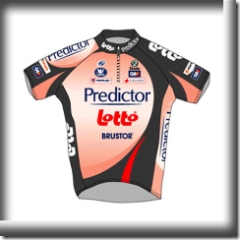 Blame it on the Pros
Blame it on the Pros
The most obvious reason we have such ugly jerseys is because we’re used to seeing ugly jerseys. The pro teams out there are beholden to whoever their sponsor is at the moment, which really means that they’re beholden to the disgruntled designer/would-be-artist at the outsourced marketing company their sponsor is currently using.
And what is the designer’s job? Simple: make the jersey into a billboard.
They do a fine job of this. And the pro cyclists, since they get paid to wear the billboard — even if the billboard is advertising a home pregnancy test, and the color of the jersey is what you get when the result is positive – don’t put up a fuss.
The weird thing is, though, we normal people don’t get paid to wear the billboard, but we do anyway. This can be explained with the following perfectly logical reason: we are sheep. Colorblind sheep. Colorblind, aesthetically blinkered sheep.
Though I bet there are very few men or women out there in the universe willing to spend their own money on wearing a jersey advertising a home pregnancy test.
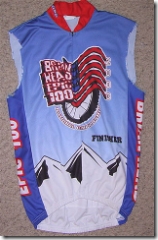 It Was Free
It Was Free
I’ll bet each and every one of us has at least one jersey that we wouldn’t pay a dime for. But since we got it as part of the schwag bag for doing an event, well that’s a different story.
Here’s the thing about those event jerseys: they’re designed by the guy on the event committee who wasn’t there to devolunteer himself on the day they chose an event jersey designer.
There’s an upside to those ugly event jerseys, though. Since you didn’t pay for them, you don’t have to feel even remotely guilty for “customizing” them. Here, for example, is my jersey for the 2003 Brian Head Epic 100. (I tell you that, because the text on the jersey itself is nigh unto illegible, and it’s worse in real life). I transformed it into a sleeveless jersey in the middle of a ride a couple weeks ago, using nothing but my teeth to take out a couple stitches, and then using my patented super ripping technique.
I had an intriguing tan pattern by the end of the ride.
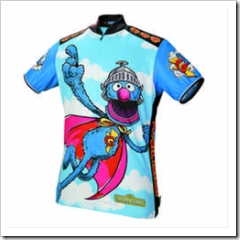 It’s Hilarious
It’s Hilarious
You know what would be really, really funny? If someone put a picture of Grover on a jersey! Or of a skeleton riding a bike! Or of a Reese’s Peanut Butter Cup!
Actually, that last idea is quite awesome.
The problem with comedy-based jerseys is that punchlines are only funny for three seconds. Scientific fact. But if you’re wearing a comedic jersey, you’re wearing it for the entire ride. The timeline of your riding companions’ impression of your funny jersey is as follows:
- Seconds 0 – 3: Hey, that’s funny! A jersey with Grover on it! That’s both clever and whimsical!
- Seconds 4 – 10: But why is it the “Super Grover” character? And why is he flying? That’s not all that funny anymore.
- Seconds 11 – 20: What kind of person wears an image of a bumbling muppet? Why would anyone pay money to wear an image of a bumbling muppet on a bike ride? And it’s not like this is the only time he’s going to wear it, either. I’ll bet he wears that same stupid jersey next ride, too.
- Seconds 21 – Forever: I need to figure out a way to either kill this rider, tell him I’m never riding with him again, or — at the very least — destroy that moronic jersey.
In short, comedic jerseys aren’t just ugly. They’re potentially lethal. Wear at your own risk.
Design May Be Larger Than It Appears
Back in Winter, a local cycling team — Team DNA (Dirt ‘n Asphalt, get it?) — had a clever idea: make their team jersey look like it’s made of carbon fiber. The mockup looked pretty cool. I would have bought the jersey in fact, if I weren’t so lazy.
Dug and Rick Sunderlage — neither quite as lazy — succumbed to the coolness of the idea of a carbon-fiber-looking jersey and signed up.
And then the jerseys (and accompanying shorts) arrived.
Here’s Dug, modeling the ensemble. First, front:
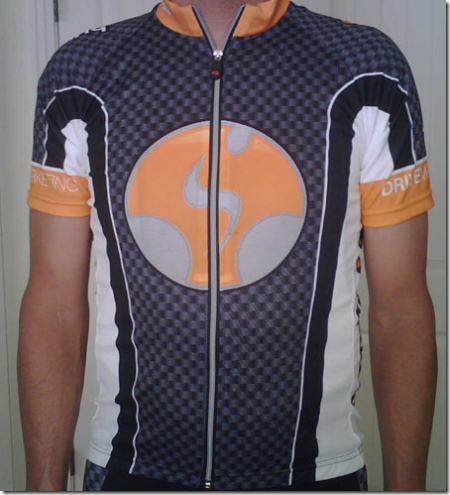
And now the shorts.
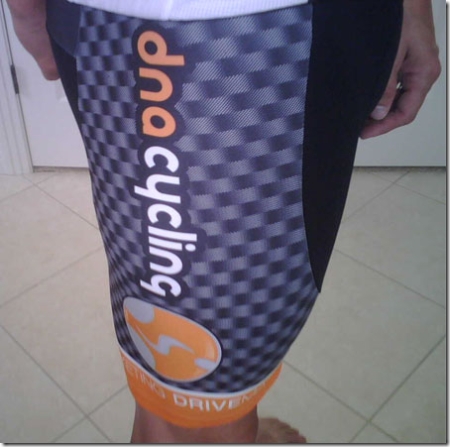
Before I go any further, I think I have the same question the rest of you have: what’s with the hand placement, Dug?
But anyway.
The problem with the mockup is that it didn’t show what the “carbon fiber” part would look like when it’s actual size, which I will hereby demonstrate:
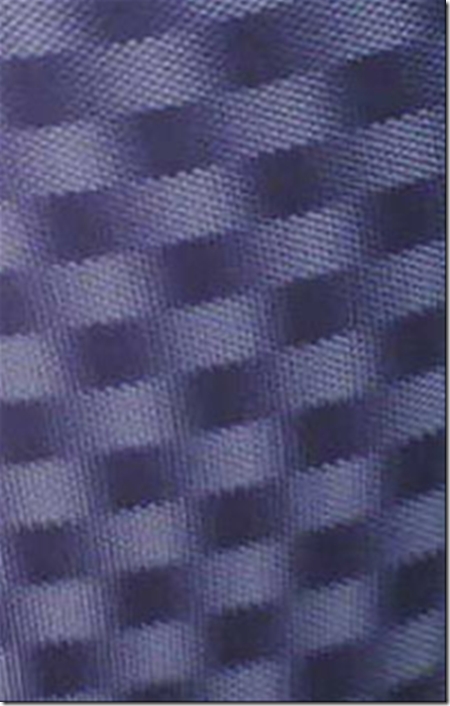
Yes, that’s right. You can play checkers on team DNA’s race kit. Or, if you stare at it long enough, you will either wreck (likely) or begin to see a 3D depiction of Grover. Flying.
Safety
I have, at times, worn astoundingly ugly jerseys intentionally, reasoning that a garish jersey is more likely to draw the attention of drivers. I don’t think that a brightly-colored jersey has to be ugly, however, so I’m rejecting that idea.
The Ugly Jersey Contest
I believe that everyone has at least one ugly jersey. And I believe it’s time to have a contest to determine: who has the ugliest jersey of all?
Let’s introduce the contest with a new cartoon from my son:
[flash http://www.fatcyclist.com/blogphotos/cyclation2.swf]
How Do You Enter?
If you’ve got an ugly jersey — or know someone else with an ugly jersey — get a picture of it and contribute it to the brand new Flickr Ugly Jerseys group I created.
Whether you’re going to submit a photo or just want to see what others are entering, you’re going to need to register with Flickr. Also, to see all the photos, you’ve got to join the Ugly Jerseys Group. Luckily, that’s relatively painless. Just do this:
- First, to www.flickr.com/signup and follow the standard signup rigamarole to get registered. Luckily, it’s free.
- This step is important. If you don’t do this, you won’t be able to see all the photos: Once you’ve registered with Flickr, you need to join the Ugly Jerseys group. That’s easy: Just go to www.flickr.com/groups/uglyjerseys/ and click Join this Group. Now you can see the photos for the photo contest at www.flickr.com/groups/uglyjerseys/pool/.
How it Works
If you know how to use Flickr, you can skip this part. If you’re new to Flickr, here’s how you upload a picture.
- Go to the Flickr Upload page: www.flickr.com/photos/upload.
- Browse for your photo(s) – you can enter up to three photos in this contest. Photos are automatically resized, so don’t stress about having it be a particular size before you upload it.
- Click the Upload button at the bottom of the screen.
- Enter captions for each of your photos. Be interesting and descriptive. If you can’t be both, be one or the other.
- Click the Save button at the bottom of the page.
- Now you’ve got to make your photo part of the Ugly Jerseys group. To do that, from your “Your Photos†page (you should be there already) click your picture. You should see options of what you can do with that photo above the picture now.
- Click “Send to Group†to make a menu drop down. From that menu, choose Ugly Jerseys.
- OK, that’s it.
Your photos should be added to the gallery pretty much immediately.
When and What You’ll Win
You have through Monday (because I’m going to be out of town for a few days) to get your ugly jerseys photographed and uploaded. I’ll then choose a winner and announce it on Tuesday. So you have plenty of time to enter.
And what can you win? Well, first prize gets a cool Fat Cyclist Special Edition Banjo Brothers Commuter Backpack.
And second prize? You get this ugly jersey, kindly donated by Julie.
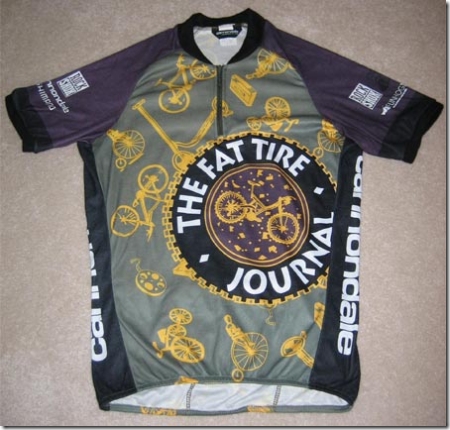
Hey, I’ve seen worse.
If you want your jersey to be one of the prizes for this contest (and are willing to pay for the shipping), indicate that on your entry, and we’ll throw that into the Ugly Jersey prize pot. I’m happy to give away as many ugly jerseys as you’re willing to contribute.
PS to Team DNA: Actually, your jersey is super-sexy. I’d still wear one, except it gives me a terrible headache to look at. Please don’t kill me.
Comments (49)
06.27.2007 | 10:57 am
I’ve been trying to keep this blog as non-mopey as possible lately, figuring that acting normal is a reasonable way to start feeling normal. Lots of you continue to send cards, email and comments, though, so I figure it’s time for an update on how things are going for Susan.
Susan’s on a three weeks on, one week off rotation for her chemo, which means that last Tuesday she didn’t have chemo. The chemo, in addition to making her tired, tends to give Susan an upset stomach, so this week off has meant that food is interesting to Susan for the first time in about a month.
Of course, yesterday was a chemo day again, so I’m guessing food is going to once again become a chore for her.
Getting Around
What sent Susan into the doctor in the first place a couple months ago was that her hip was hurting badly. And of course it turned out there was a tumor there, big enough that it was in danger of fracturing her hip. Since then, it’s become increasingly painful for Susan to get around.
Until recently.
We’ve both noticed lately that Susan’s getting around a little more easily. Her limp doesn’t slow her down as much, she lifts things without as much pain, and she gets up and down stairs more quickly. We’re both incredibly encouraged by this, and choose to think this means that the chemo’s doing its job. Susan told her doctor she’s getting around better, and the Doctor agreed it’s a good sign.
What is Susan doing right this second? She’s taking the girls to their swimming lessons.
Hair
One of the things chemo does is kill hair follicles — moreso for some people than others. Susan’s hair started going pretty fast about a week ago. Rather, though, than let it get increasingly patchy (and have the nuisance of having hair all over her clothes constantly), Susan had me shave it all off with the electric razor.
I volunteered to take the razor to her head afterward, reasoning that I am getting pretty good at this now. Susan declined.
The boys took all this in stride — they’ve seen Mom without hair before. The twin girls — each of which firmly believes she is a Disney princess — freaked out when they first saw her. That lasted about fifteen minutes, though, and now they like to kiss mom on the head, just like they do for me.
Susan has a wig from when she went through chemo the first time a few years ago, and I’ve told her we could get her as high-end of a new wig as she likes, but — at least for now — Susan’s not wearing a wig at all, instead going with bandanas (we bought about a dozen at e4hats.com). For one thing, it’s hot outside and the thought of a wig is just awful. More importantly, wearing a wig feels like you’re trying to hide something you’re ashamed of, and Susan has nothing at all to be ashamed of.
I’ve never liked long hair. Susan looks great now.
Circle this Date and Pray Like Crazy
So here’s where things stand right now. On July 20, Susan will be getting a CT scan. A week later, the doctor will tell us whether the cancer is shrinking, staying the same, or growing. If you’re the praying sort, we’d appreciate your prayers that the chemo will do its job and the tumors — especially the ones in her lungs – will shrink. If you’re the meditative sort, we’ll be grateful for any positive thoughts/energy/karma you can send our way.
And again, thanks very much for your kind thoughts, comments, email, cards, and other messages. They mean a lot to Susan and me.
PS: I talked to the Twin Six guys yesterday, asking if they’ve heard anything about when the special pink edition of the jerseys will be arriving. They told me that the manufacturer sent them Monday, so they’ll be arriving at Twin Six later this week, and then shipping out. T-shirts have already arrived and are starting to ship out, and socks will be arriving any day now. As soon as I get my order, you can be sure I’ll be posting pictures. Big thanks to everyone who’s ordered anything at all.
Comments (77)
06.26.2007 | 3:22 am
“Mountain Biking” is too big a term.
Consider this. Last Saturday, a small group of friends — Dug, Kenny, Dan, Racer — and I went mountain biking. It was a seven-hour epic circumnavigation of Mount Timpanogos: thirty seven miles, the first 22 of which took almost six hours (yes, we averaged about four miles per hour) because it was so brutally steep.
Dug and Racer had their cameraphones with them, and so got a few pictures.
The ride starts with a ride along the Bonneville Shoreline Trail, which connects to Grove — a narrow, steep, shale-strewn trail with a clff going up to your left and, often, a cliff going down to your right. Here’s Racer riding up:
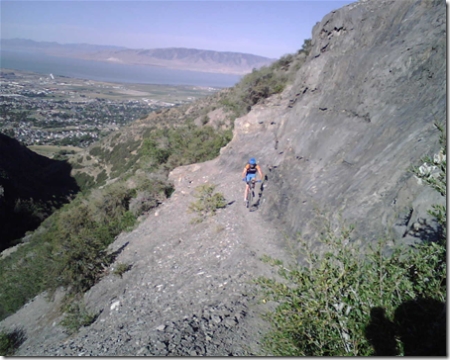
After about 2000 feet of climbing (which means you’re a third of the way up), there’s a stream crossing. Here’s Kenny, looking sassy.
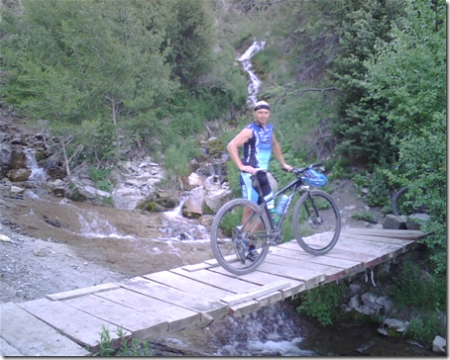
And here’s Dug, putting the stream to more practical use.
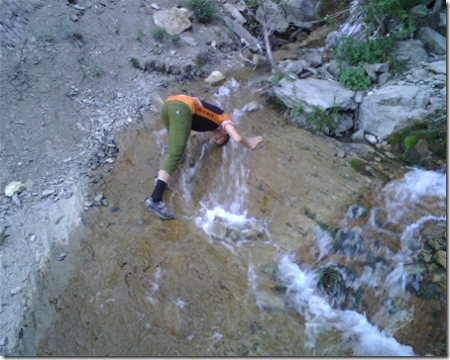
After about four hours, you get a brief break from climbing as you descend from the top of Timpooneke to the Timpooneke trailhead (watch out for bears!). During this descent, I took a hairpin too tight and augured in, briefly dislocating my shoulder. This happens so often that by the time Dug got out his camera to take a picture, I was composed and smiling again.
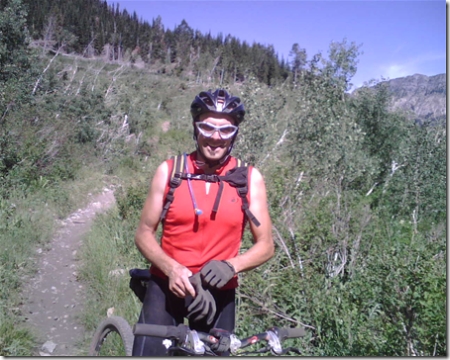
For those who have been wondering, that helmet’s a black Giro Atmos, by the way.
Next up is a climb to Julie Andrews Meadow. Yes, it’s really named that. The urge to spin around, arms flung wide, and sing “The Hills Are Alive” is nearly irresistable. Here’s Dan — doesn’t he look like he’s about to break into song?
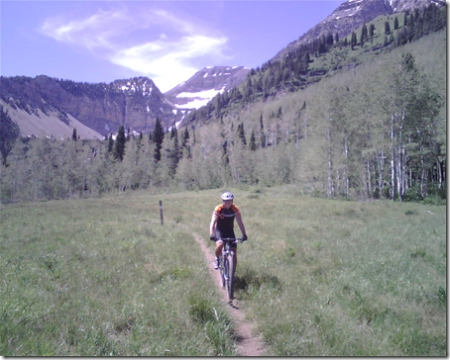
Once you get to the Summit, your six hours of climbing earn you about twenty minutes of descending, at which point you’re at the Sundance Ski Resort having a giant macadamia nut cookie (me) or a beer (Kenny):
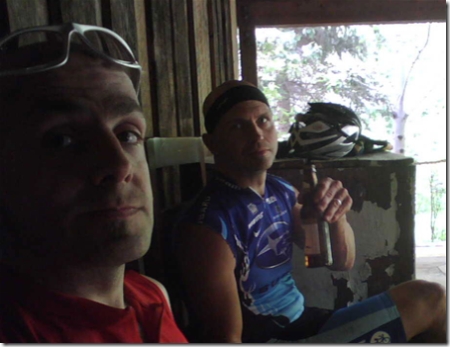
Rocky’s Ride
Also last Saturday — 250 miles away — my brother-in-law Rocky went mountain biking.
Kellene sent me some pictures, though I’ll have to improvise the story. Here’s Rocky, riding down an impossibly steep, boulder-strewn pitch toward certain death.
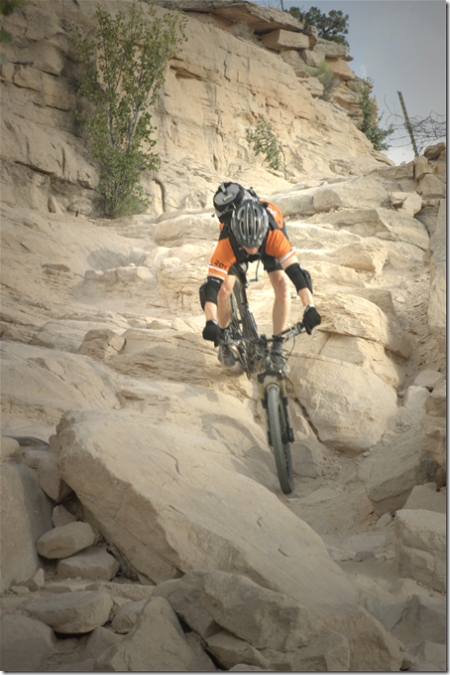
And here’s Rocky, again. This time he’s riding down an impossibly steep, boulder-strewn pitch toward certain death.
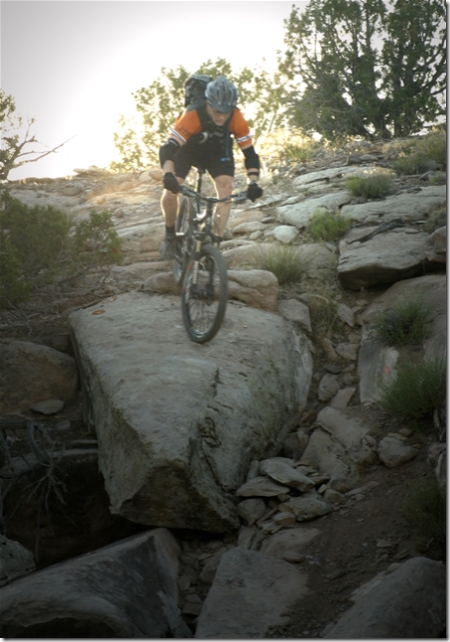
And here’s Rocky, now with his bike so impossibly positioned that I can confidently say he is one single moment from his demise.
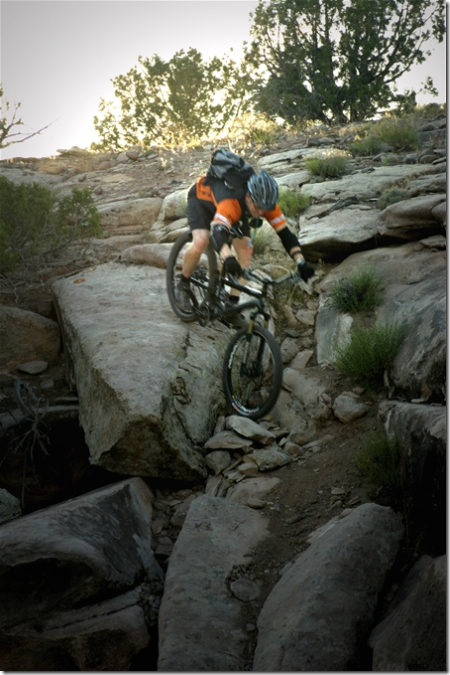
And finally, here’s Rocky, evidently committing suicide:
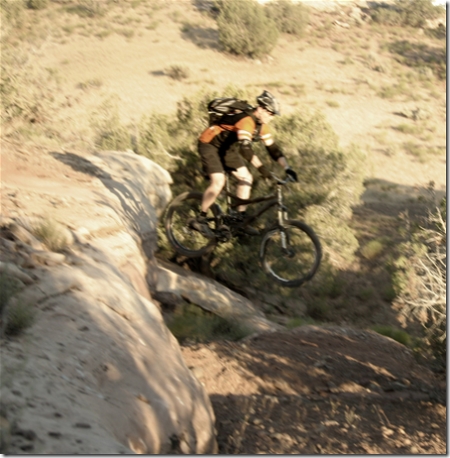
So here’s the thing. If someone tells you they went out road biking, you have a good idea of what went on. You may not have an idea of how far, how fast, or how steep, but you know what road biking looks like.
If someone tells you they went mountain biking, on the other hand, you still don’t know anything.
PS: In these photos, Rocky is wearing the exact same kind of Camelbak I wore when racing the Kokopelli Trail (i.e., a ginormous one). The primary differences are:
- His Camelbak is fuller than mine was for a 20-hour ride
- He’s out on a two-hour ride
This leads to an interesting question: What is Rocky carrying? My current theories include:
- A picnic lunch for 12
- A parachute
- 6 gallons of water (Rocky sweats at a rate of 1 pint / minute)
- A large tub of Whupass Jam
- A very extensive first aid kit
By all means, you should feel free to speculate too.
Comments (65)
06.24.2007 | 9:01 pm
Many people have noticed, lately, that I am an excellent climber. Fast. Focused. Featherweight. Also, I am very, very handsome, but that is the subject for another post on another day.
It is not uncommon, truth be known, for me to receive requests for climbing guidance from professional cyclists, though I am contractually obligated to not mention these cyclists by name. Considering the remarkable sums of money these people are paying me, I am more than happy to respect their need for privacy.
Because I value you, dear reader, above all my (very, very) high-paying clientele — and because I know that the only reason you do not gladly pay a $49.95 monthly subscription to this site is that I do not ask it of you — I shall today offer you the same guidance. At no charge whatsoever.
Today, I shall tell you how to fly up the hills. Today, my friend, you shall be transformed.
The Easy Parts
There are three crucial components to being a magnificent climber. No, of course you cannot expect to be as magnificent as I am, but you can become at least relatively magnificent, and you should be satisfied with that.
The first two parts are simple, but the basics must not be ignored.
First, you must pedal. Some fools believe that they can simply coast uphill, through the medium of offering promissory notes to gravity against future descents. And while I have patented this idea and have built a prototype drivetrain that successfully implements this theory, it is not yet available for production or sale. The reasons are technical, but basically boil down to a problem with the elastic bands breaking.
It is not enough to pedal, though. You must pedal in sine waves. Yes, I know: conventional cycling wisdom would have you pedal circles. But conventional cycling wisdom doesn’t get paid ridiculously large sums of money by the top pro cyclists in the world, now, does it? Consider the motion of a pedal as it goes by you. Is that pedal going in a circle? No. It’s oscillating up and down as the bike moves forward. A sine wave. How will this help you pedal better? It won’t, but it’s still true.
Second, you’ve got to stop braking as you climb. It just slows you down.
How to Be Light
Once you’ve got the basics — do pedal (in sine waves), don’t brake — down, you’re ready for the vital third step in becoming a climbing powerhouse.
You must become light.
Many cycling pundits think they understand this vital technique for being a world-class climber, but they don’t. Not really. All they know are the crude basics: lose weight, ride a light bike. Sure, that’s fine as far as it goes, but the details — how do you lose weight? How do you make your bike light? — are where traditional givers of advice will fail you.
I, dear reader, will not fail you. The following strategies will help you become the climber you have always dreamed of becoming. (Unless, of course, you have been dreaming of becoming as good a climber as I, because that would be laughable. Set your sites on something attainable, you charlatan!)
Techniques for Making Yourself Light
Most cyclists believe they already know how to make themselves light — diet and exercise — and that the only variables are time and willpower.
Nothing, I am happy to say, could be further from the truth.
This is all you need to do:
- Shave. This has been considered good practice among cyclists for years, but the full extent and reasoning behind shaving has never been fully explained. Shave everything. Head to toe. This includes your eyebrows and eyelashes. No decorative facial hair (this goes for you too, ladies). Not only is hair non-aerodynamic; every single little hair has weight. In fact, don’t just shave. Wax. That way you can get the hair beneath the surface of the skin. Special note to Tinker Juarez: You could be fourteen pounds lighter if you got rid of all that hair.
- Exfoliate: I’m not talking here about using a mildly abrasive skin cleanser here. I’m prescribing a twenty minute session, top to bottom, with 80 grit sandpaper. Some people might call this torture. I call it the cost of greatness.
- Avoid Sunscreen: This one’s easy. You know all that sunscreen you rub onto your skin? Yeah, you think it doesn’t weigh anything? Well it does. Stop using it; it’s weighing you down.
- Fingernails and Toenails: I know, you already trim your fingernails and toenails nice and tight. That’s a good first baby step. Now finish the job. All the way to the cuticles, champ.
- Liposuction: Some people call this unnecessary surgery with no demonstrable long-term benefit. I call it the shortest route from point Fat to point Fast.
- Remove unnecessary body parts: Do you know what your tonsils are good for? How about your appendix? Nothing, that’s what. So what are you carrying them around for? And while we’re having this discussion, answer me this: do you really think you’d walk any worse if you removed your pinky toes? And don’t even get me started on the dead weight everyone dangles around by virtue of keeping their earlobes.
- Remove unnecessary decoration: Got a tattoo? You think that ink doesn’t have mass? Ha.
- Dehydrate: Many cycling authorities encourage you to stay hydrated if you want to ride well. I’ll let you in on a little secret: they tell you that because they’re coaching someone else they want to beat you. The truth is, water is incredibly heavy. And while I recognize it as a necessary evil (my kidneys sometimes fail when I let my water mass dip below 40%), I’m not going to lug any more up the hill than I have to. You shouldn’t either. I recommend going without fluids for at least 36 hours before a ride of any significance. Then, during the ride, spit. A lot. And don’t drink anything.
- Bloodletting: This got a bad rap because it was invented back in the medieval ages, but just because something was invented a long time ago doesn’t mean it was a bad idea. I mean, wheels were invented a long time ago too and I don’t see you rushing to eliminate those from your cycling rig.
Techniques for Making Your Bike Light
Many people spend thousands upon thousands of dollars to make their bikes light. I heartily endorse this behavior. In addition to purchasing lighter parts, though, you should also consider making your bike lighter through the medium of removing bike parts. For example:
- Remove the rear brake: Everyone knows that most of your stopping power is in the front brake. So why incur the expense and weight of that redundant rear brake? A good modern front brake has enough stopping power and then some. You know how much weight you’ll save by getting rid of the rear brake, cabling, and levers? Fourteen pounds, that’s how much. Most people don’t realize how heavy rear brakes are.
- Remove the bottle cages: Since you aren’t going to be drinking when you ride anymore (see “Dehydrate,” above), you won’t be needing those bottle cages anymore, will you? Nor the bottle cage bolts.
- Sand the paint job off: I’ve heard that some bike manufacturers put between 2-5 coats of paint on their bikes, and then seal the job with a high-gloss finish. For those manufacturers, I have a question: Do you you also insert lead weights into the tubes? Because you may as well.
- Never carry a saddlebag: You know, I have ridden hundreds of times without any tools or flat-fixing supplies without ever missing them. In fact, the only time I have ever missed not carrying stuff to do bike field repairs is when my bike breaks or flats. And that’s hardly ever.
- Never let your sweat drip onto your bike: You’re going to sweat when riding (although if you’ve done your dehydrating properly, you won’t sweat much). Just don’t sweat on your bike. That leaves a salty residue, and salt has mass.
- Helium: Fill your tires with helium. Fill your bike tubes with helium. Before rides, breathe a helium/oxygen mix, which is 30% lighter than conventional air. I do not understand why so few people understand this.
Techniques for Making Your Clothing Light
Over the centuries, cycle clothing manufacturers have refined their wares to the point where cyclists can be comfortable in the saddle all day.
But being comfortable isn’t the point, is it? Being light is the point. Here is how to customize your bike clothing to get rid of that ungainly bulk:
- Get rid of the pockets: You’re not carrying anything in your jersey pockets, are you? Of course you’re not, because anything in those pockets is going to weigh something. And since you aren’t using those pockets, you may as well get rid of them.
- Get rid of the armpit fabric: Cutting a gaping hole in your jersey directly beneath the armpit serves dual purposes. First, it makes the jersey lighter. Second, it has a cooling effect, which is useful since you won’t be sweating much anymore and will be more susceptible to heat stroke.
- Get rid of the collar: Are you going to wear a tie with that jersey? No? Well then, what’s the collar for? I mean, besides to weigh you down?
- Shorten your shorts: When you get right down to it, the primary function of the bike short is to hold the chamois in place. So why do they go all the way down onto your thigh, sometimes almost to the knee? Chop them off higher and you’ll get rid of several unsightly tenths of an ounce. And you’ll get a nice tan on more of the tops of your quads.
Final Analysis
Do I expect many cyclists to follow my advice? No, no I do not. And why will most of you snigger and ignore me? Because most of you are not truly committed climbers.
Just you wait, though. In a few short days the Tour de France will be on TV and — as you see cyclists with the healthy glow of freshly sanded skin, the dull gaze of people who have not had a drink in two days, brakeless (and paintless) bikes and sheared short shorts, that not everyone has been laughing off my (very, very) wise (and, frankly, expensive) counsel.
And then you too will do what it takes to be light.
Comments (64)
06.22.2007 | 12:02 pm
Last night, my wife asked me if I was getting excited for the Tour de France. I’m sad to say that I am not. I’ll still watch it, but I’m not clearing the decks and planning my life around it the way I have for the last ten years or so.
It’s not so much that I’m disgusted with the organization or the racers. It’s more that the race has kinda lost its validity. Are the racers who will be starting really the fastest cyclists alive? Or are they just the fastest clean cyclists alive? Or are they just luckier than the guys who got caught?
For the record, I’m rooting for Vinokourov, because he makes me laugh. But that’s not exactly a prescription for a riveting race, is it?
You want to know what multi-day race is holding my attention? The Great Divide Race – a self-supported mountain bike race from Canada to Mexico that can last close to a month – is, that’s what.
Allure of the Nearly Possible
I have no illusions about whether I could ride in the Tour de France. My genetics aren’t even close. Even if I had trained perfectly my entire life, I couldn’t be one of those guys.
I cry every time I admit that fact.
I also have no illusions about whether I could do the Great Divide Race (GDR). I don’t have the time, and I don’t like camping. And I’m in nothing close to good enough shape
But if I decided to make it my life’s mission, well, maybe I could do the GDR.
Maybe.
If I didn’t have any mechanicals, the weather was good, and the bears left me alone. Then maybe.
I think that “maybe” is what makes the difference between admiring a race and getting sucked into it heart and soul.
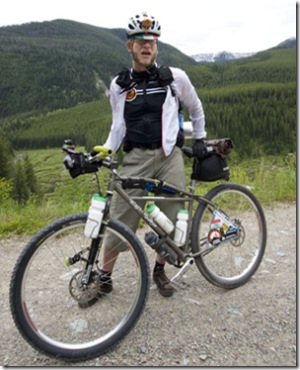 Go Dave!
Go Dave!
Another part of what’s got me obsessively tracking this race is the fact that Dave Nice – the guy Fat Cyclist readers raised $1200 for — is racing wearing the Fat Cyclist jersey (Photo by Aaron Teasdale of Adventure Cycling Association (ACA). Used with permission, believe it or not).
And while there’s no such thing as an “easy way” to do this ride, Dave’s about as hardcore as they come. His bike’s a rigid, fixed 29er. His pedals do not have clips. His shorts do not have a chamois.
And to top it all off, Dave has vowed to not eat anything he does not personally either harvest or kill during the entire ride.
OK, I made that last part up. But still.
Meet the Riders
If you want to get sucked into a real-life, month-long drama like I am, a good place to start is with this first day photo essay Aaron Teasdale of ACA put together. You’ll meet the riders, learn what they look like and what they’re hoping to accomplish.
Then, once you’ve done that, just head on over to these places to follow the adventure:
- Updates from the riders’ mouths: This is what makes the race so compelling, if you ask me. Racers are given a toll-free phone number to call whenever they get into a town. They give updates, which are transcribed into this running report.
- Get background and summary info: ACA has a great portal to the route and information about the riders and past editions of the races. Definitely worth boning up on.
What Makes the GDR Great
I love hearing how the race is going, unedited and unfiltered, right from the racers’ mouths. For example, as of last night, Dave was spending a second day in Butte, exhausted from his fixed-gear trek so far. From the way it’s transcribed, Dave is so tired he had to pause to remember his last name.
It’s very common for racers to call in and start giving a report, only to realize that they don’t even know what town they’re in. Or to report that they had to spend a day in a sleeping bag, vomiting and exhausted, but now they can walk again and so are heading out.
It’s the very mundaneness of the calls that makes them interesting to me, because I can imagine myself making a similar call. “Hi, uh, I know a lot of stuff happened today, but right now I’m so cooked all I can think about is sleeping. I’m hungry, but I can’t eat. I need to get out my camping stuff now, so I’ve gotta go.”
Food, shelter, sleep. That’s what’s on these guys’ minds. Totally primal.
I love it.
Integrity
You know what else I love about this race? The concern over cheating. In particular, it’s the obsessive aversion to cheating that seems so prevalent. Consider this: the rules say that you can’t accept a ride. But there’s a paved section on the trail right now that is one lane wide and requires cyclists to ride in a pilot car. Pete Basinger tells a story of how he argues with the flag lady for half an hour, finally agrees to ride in the pilot car (downhill) for the three mile stretch, then gets out and continues on his ride.
And it eats at him. And eats at him.
So after thirty miles, Pete turns around and rides back, and rides that construction section after all the workers have gone home.
Call it a hunch, but I’m guessing that Pete’s not sneaking EPO to win this race.
Comments (22)
« Previous Entries Next Page »
 Blame it on the Pros
Blame it on the Pros It Was Free
It Was Free It’s Hilarious
It’s Hilarious














